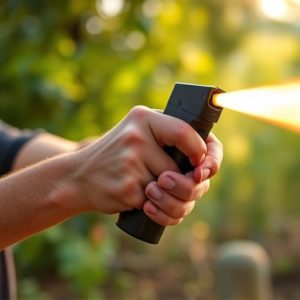Pepper Spray & Decontamination: Safeguarding Your Home and Understanding Non-Lethal Deterrents
Pepper spray, a popular non-lethal deterrent, requires proper usage and decontamination for safety……..
Pepper spray, a popular non-lethal deterrent, requires proper usage and decontamination for safety. At home, follow these steps: ventilate and clean surfaces with water, dispose of materials responsibly, rinse and wash affected items, disinfect high-touch surfaces, and consider multi-layered home security measures like robust locks, motion sensors, and smart systems for comprehensive protection.
“Personal security is a growing concern, prompting the search for effective non-lethal deterrent devices. This comprehensive guide explores an essential tool in modern self-defense: pepper spray. We delve into its mechanism, benefits, and drawbacks as a personal security measure. Furthermore, we provide practical decontamination steps for those who use pepper spray to protect their homes. Finally, we offer strategies to enhance overall home safety, going beyond traditional pepper spray.”
- Understanding Non-Lethal Deterrent Devices: A Comprehensive Overview
- Pepper Spray as a Personal Security Tool: Pros and Cons
- Decontamination Steps: Safeguarding Your Home After Use
- Enhancing Safety at Home: Beyond Pepper Spray
Understanding Non-Lethal Deterrent Devices: A Comprehensive Overview
Non-lethal deterrent devices, such as pepper spray, have gained significant attention for personal security. These tools are designed to incapacitate or deter potential attackers temporarily, allowing individuals to escape or seek help. Pepper spray, in particular, is a common choice due to its effectiveness in causing temporary blindness and respiratory distress in the target. Understanding how to use and decontaminate these devices properly is crucial for their optimal functionality and user safety.
The decontamination steps for pepper spray at home involve several essential procedures. After use, immediate washing of the affected areas with plenty of water is recommended. This includes eyes, face, hands, and any other exposed skin. Additionally, changing clothes and thoroughly cleaning clothing that may still have residual spray can prevent further irritation or potential cross-contamination. It’s important to keep pepper spray out of reach of children and pets, storing it in a secure location to avoid accidental exposure and maintain its effectiveness for future use.
Pepper Spray as a Personal Security Tool: Pros and Cons
Pepper spray has long been a popular choice as a personal security tool, offering individuals a means to deter potential attackers and create an opportunity for escape. As a non-lethal deterrent, it provides a layer of protection while allowing for a temporary but effective neutralization of an assailant. The key active ingredient in pepper spray is capsaicin, the same chemical that gives chili peppers their heat. When sprayed into the eyes and respiratory system, capsaicin causes intense irritation, disorienting the attacker and providing precious time for the individual to get away.
However, like any security device or strategy, pepper spray has its advantages and disadvantages. Pros include its ease of use, portability, and immediate effect. With proper training, individuals can learn how to deploy it effectively in various situations. The decontamination steps after using pepper spray are also relatively straightforward at home, typically involving thorough washing with soap and water to remove any residual chemical from skin and clothing. Cons include the possibility of cross-contamination, as the spray can stick to surfaces and clothing, affecting bystanders or causing accidental exposure. Additionally, some individuals may have allergies or sensitivities that could result in adverse reactions to pepper spray.
Decontamination Steps: Safeguarding Your Home After Use
After using a non-lethal deterrent like pepper spray, decontaminating your home is crucial to ensure safety and prevent any lingering effects. Start by ventilating the area thoroughly; open windows and doors to allow fresh air in and disperse any residual chemicals. Next, clean all surfaces with a damp cloth or sponge, focusing on areas where the spray was applied or aerosolized. Dispose of the used cleaning materials responsibly, as they may still contain trace amounts of the irritant.
Rinse all affected items, such as clothing or personal belongings, in water to neutralize the pepper spray. Soak them for several minutes, then wash as usual. For skin contact, immediately rinse with warm water for at least 15 minutes. If irritation persists, seek medical attention. Lastly, consider decontaminating high-touch surfaces like doorknobs, light switches, and phones using a disinfecting solution to minimize the risk of further exposure.
Enhancing Safety at Home: Beyond Pepper Spray
Many people rely on pepper spray as their primary non-lethal deterrent for personal security, both in and outside the home. However, going beyond traditional pepper spray can significantly enhance safety measures at home. Beyond decontaminating the area after use, it’s crucial to understand that pepper spray is just one tool in a comprehensive security strategy. Homeowners can strengthen their defenses by investing in multiple layers of protection, such as robust door and window locks, motion-activated lighting, and advanced security systems that integrate smart home technology.
Implementing these measures alongside pepper spray creates an environment where potential intruders are deterred at every step. Moreover, establishing clear safety protocols for all family members ensures everyone knows how to respond during unexpected events. Regularly practicing decontamination steps – like immediately flushing eyes with water and removing contaminated clothing after pepper spray use – is also vital. This proactive approach to home security cultivates a safer living environment beyond the immediate effects of pepper spray.
Non-lethal deterrent devices, such as pepper spray, offer a valuable layer of personal security. While this article has focused on pepper spray as a common choice, it’s essential to remember that enhanced home safety involves a multifaceted approach. After considering the pros and cons of pepper spray use, understanding decontamination steps is crucial for both personal safety and ensuring your home remains secure following its application. Beyond pepper spray, exploring additional security measures can create a comprehensive strategy for protecting yourself and your loved ones.

